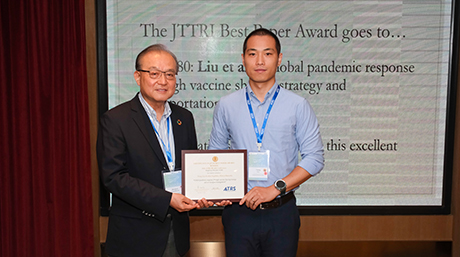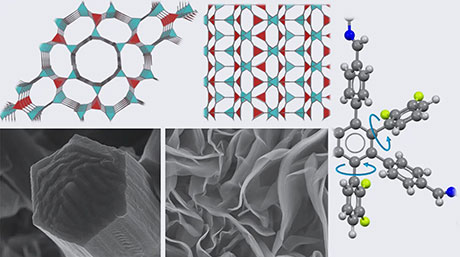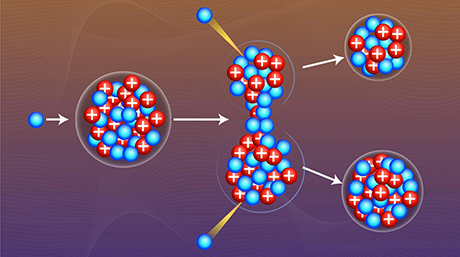Transdisciplinary Science and Engineering News
α-Al₂O₃ Protective Layer That Sticks to Metal Surface with Functions of an Anchor and Peg
Elucidating the mechanism of protective layers on fusion reactors that resist peeling
Fusion reactors, fast breeder reactors, and solar thermal power plants are being developed as power plants with low environmental impact and no resource constraints. Since these power plants operate at high temperature with large-heat transfer, scientists are studying the use of components that use liquid metal (has excellent heat transfer performance) as a coolant. The liquid metal blanket (a metal wall installed in the core) and the liquid metal divertor (receives heat and discharges exhaust) are among the most important components of fusion reactors and have attracted attention as innovative energy conversion devices. However, the selection of structural materials that are chemically compatible with high-temperature liquid metals has been a challenge.
Associate Professor Masatoshi Kondo of Tokyo Institute of Technology has taken liquid metal coolants and conducted research on their chemical corrosion resistance with leading structural materials. He found that the cause of corrosion is the leaching of metallic components from materials in contact with liquid metal and the alloying of liquid metal and steel materials. In that context, he found that corrosion can be significantly reduced by forming a compact protective oxide layer on the surface of structural materials of liquid metal components. The formation of a stable protective oxide layer that inhibits such corrosion is key to making liquid metal-based components a reality.
The joint research team, led by Associate Professor Kondo, in collaboration with Yokohama National University and National Institute for Fusion Science, focused on the fact that oxide dispersion strengthened (ODS) FeCrAl alloys form an α-Al2O3 (alpha alumina) layer consisting of a compact structure, and identified factors that can promote layer growth and the mechanism that makes the layer resist peeling off from the substrate.
The α-Al2O3 layer provides outstanding protection in high-temperature liquid metal environments. The ODS Fe15Cr7Al alloy has excellent high-temperature strength and is a strong potential structural material for next-generation power plants. The alloy can be oxidized at 1,000℃ in air for 10 hours to form an α-Al2O3 layer. Figure 1 shows cross-sectional microscope image of the α-Al2O3 layer formed on the ODS Fe15Cr7Al alloy and the distribution of its constituent elements. Although it is only 1.28 micrometers thick, about 1/80th the thickness of a human hair, it has an extremely compact structure with uniform distribution of aluminum and oxygen, as shown in Figure 1(b). At the same time, the team found that oxides of reactive elements such as Ti, Y, and Zr were formed in the α-Al2O3 layer, as shown in Figure 1(c). This is because the reactive elements that the ODS Fe15Cr7Al alloy holds dispersed as tiny oxide particles in its microstructure have migrated into the layer to form oxides. Comparison of the microstructure and growth rate of the oxide layer formed by several types of FeCrAl alloys shows that alloys without reactive elements do not form these oxides in the layer, and their layer growth is slow. These elongated oxides of reactive elements act as "oxygen-only diffusion path" that promote layer growth and improve barrier properties (Figure 2).

Figure 1. Cross-sectional microstructure of α-Al2O3 layer formed by ODS Fe15Cr7Al alloy
-
(a) Scanning transmission electron microscope image; (b) Energy dispersive X-ray (EDX) elemental mapping image of aluminum and oxygen; (c) Elemental mapping image of titanium, yttrium, and zirconium by EDX analysis
-
(a) Scanning transmission electron microscope image; (b) Energy dispersive X-ray (EDX) elemental mapping image of aluminum and oxygen; (c) Elemental mapping image of titanium, yttrium, and zirconium by EDX analysis
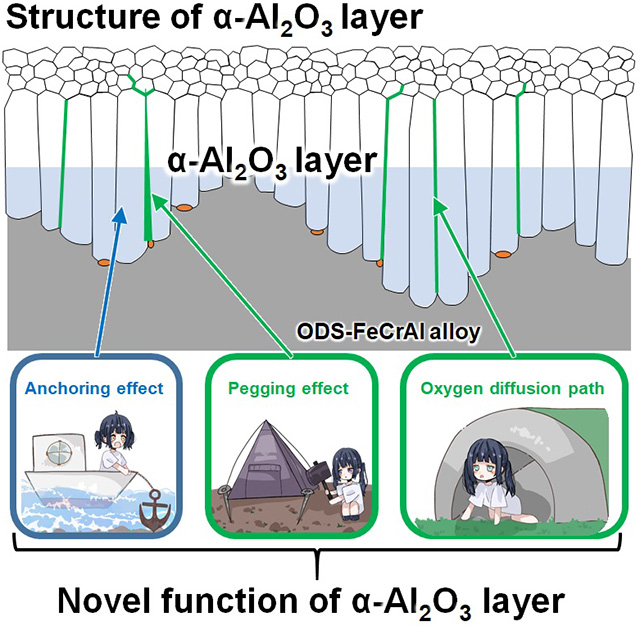
Figure 2. The mechanism by which the α-Al2O3 layer becomes resistant to exfoliation
The protective layer must be resistant to exfoliation. In this study, the team performed a scratch test on the α-Al2O3 layer formed on the ODS-FeCrAl alloy to measure the magnitude of the force required to scratch and peel the layer with a sharp needle. The results show that the ODS-FeCrAl alloy has excellent adhesion properties. The mechanism by which the α-Al2O3 layer becomes resistant to exfoliation is summarized in Figure 2. First, the oxides of reactive elements formed from the substrate toward the layer grab the microstructure of the layer tightly, like pegs used to secure a tent, and contribute to the improved adhesion strength. This is called the pegging effect.
An unstable interface with jugged structure was formed between the α-Al2O3 layer and the substrate, and as shown in Figure 3(a), the depth of this jugged interface deepens as the layer grows thicker. Furthermore, as shown in Figure 3(b), the deeper the jagged interface, the greater the shear stress required to peel the α-Al2O3 layer, i.e., the stronger the layer adhesion strength. In the pattern with the oxygen diffusion path described above, layer growth is promoted in a moderately non-uniform manner, resulting in a deeper jagged interface and a strong anchoring effect. There are other methods of forming oxide and other layers through a solution, but compared to such methods, the layers formed in this study have stronger adhesion and can withstand the flow of liquid metals with the compact structure.
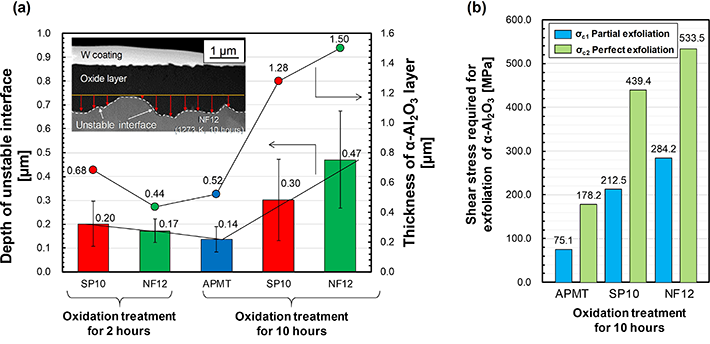
- Figure 3
- (a) Relationship between α-Al2O3 layer growth and depth of unstable interface structure, (b) Shear stress required to detach α-Al2O3 layer
- Figure 3 (a) Relationship between α-Al2O3 layer growth and depth of unstable interface structure, (b) Shear stress required to detach α-Al2O3 layer
The development of a compact, peel-resistant barrier technology has provided a promising outlook for extending the service life of liquid metal components such as liquid blankets and divertors. The implementation of liquid metal technology in advanced power plants such as fusion reactors and in desalination and environmental cleanup technologies is expected to spur the creation of a carbon-neutral society.
- Reference
| Authors : | Yoshiki Kitamura1, Masatoshi Kondo2, Naoko Oono-Hori3, Yoshimitsu Hishinuma4 |
|---|---|
| Title : | Excellent adhesion of protective α-Al2O3 layer formed on ODS FeCrAl alloys |
| Journal : | Surface and Coatings Technology |
| DOI : | 10.1016/j.surfcoat.2023.129787 |
| Affiliations : | 1Tokyo Institute of Technology, School of Environment and Society, Department of Transdisciplinary Science and Engineering, Graduate Major in Nuclear Engineering 2Tokyo Institute of Technology, Institute of Innovative Research, Laboratory for Zero-Carbon Energy 3Yokohama National University 4National Institute for Fusion Science |
|
* Corresponding author's email: kondo.m.ai@m.titech.ac.jp |
|
- Selecting the right structural materials for fusion reactors | Tokyo Tech News
- Research video: Liquid Metal, Shaping the World | Tokyo Tech News
- Sustainable construction using eco-friendly concrete: Press webinar with Assoc. Prof. Masatoshi Kondo | Tokyo Tech News
- KONDO Laboratory (Japanese)
- Masatoshi Kondo | Researcher Finder - Tokyo Tech STAR Search
- Liquid Metal, Shaping our world— Tokyo Tech Research | YouTube
- Department of Mechanical Engineering, School of Engineering
- Nuclear Engineering Graduate Major|Education|Department of Transdisciplinary Science and Engineering, School of Environment and Society
- Transdisciplinary Science and Engineering Undergraduate Major|Education|Department of Transdisciplinary Science and Engineering, School of Environment and Society
- Institute of Innovative Research (IIR)
- Laboratory for Zero-Carbon Energy
- Yokohama National University
- National Institute for Fusion Science
- Latest Research News
School of Environment and Society
—Creating Science and Technology for Sustainable Environment and Society—
Information on School of Environment and Society inaugurated in April 2016
Further Information
Associate Professor Masatoshi Kondo
Laboratory for Zero-Carbon Energy,
Tokyo Institute of Technology
Email kondo.m.ai@m.titech.ac.jp
Tel +81-3-5734-3065

